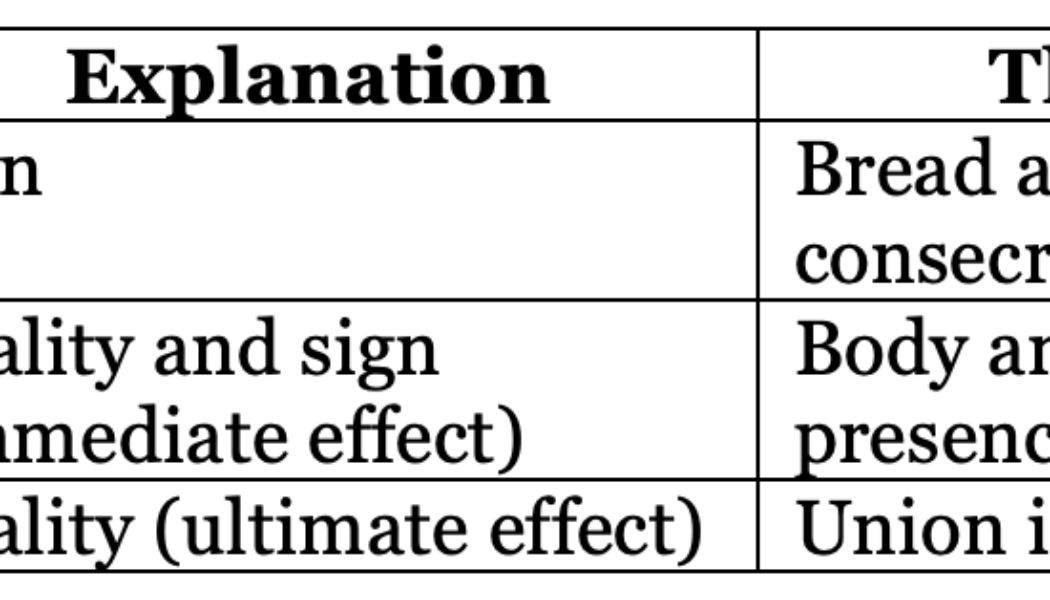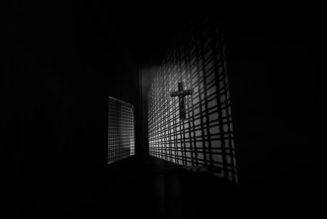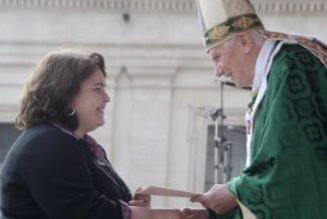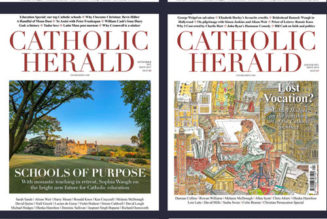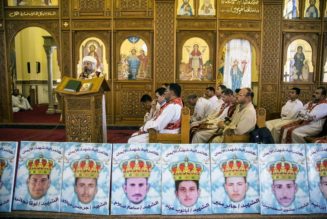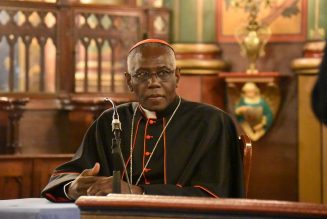Introduction
The postmodern condition leads to fragmentation and isolation.
This fragmentation makes vital the sought for healing of the National Eucharistic Revival. In its promotional materials this Revival speaks of healing through unity with Christ in the Eucharist as one of its fruits. Implicit in this is what can be termed the ecclesial dimension of the Eucharist, that is, our unity with Christ in the Church brought about through receiving Holy Communion. What we need now is to make explicit the relation between the Eucharist and the Church. This article will do so providing a brief overview of developments in twentieth century Eucharistic theology. It will also discuss how after Vatican II, in order to encourage the ecclesial dimension of the Eucharist, some theologians discouraged Eucharistic Adoration. Yet, Adoration appears to form an integral aspect of the proposed Revival. Thus, this article will also need to address whether the ecclesial understanding of the Eucharist is adversely affected by Eucharistic Adoration. Finally, we will propose that catechesis of the faithful on the relationship of the Eucharist to Baptism and Confirmation will further assist the Revival. We will ultimately contend that the unity of the faithful with Christ and in His Church (a unity brought about by the Sacraments of Initiation) will only strengthen the desired healing that the Revival seeks.
The Eucharist, the Church, and Active Participation in the Liturgy
In this section we will present the backdrop for the twentieth century developments in Eucharistic theology. In particular, we will discuss the rich theological recovery of the connection between the Eucharist and the Church. The earliest Eucharistic doctrine recorded in Sacred Scripture affirms that Christ truly gives us His Body and Blood to eat and drink (see 1 Cor 11:27) and that, in receiving Our Lord, we become changed into His Body, the Church. Thus, the ecclesial body—the Church—is generated from Christ’s Eucharistic Body. St. Paul testifies to the causal relationship between the Eucharist and the Church when he writes:
The cup of blessing which we bless, is it not a participation in the blood of Christ? The bread which we break, is it not a participation in the body of Christ? Because there is one bread, we who are many are one body, for we all partake of the one bread. (1 Cor 10:16–17, emphasis added)
This foundational connection between the Church and the Eucharist receives further testimony in the early Church Fathers. Many of the Fathers saw in the blood and water flowing from Christ’s pierced side an image of the New Eve (the Church), emerging from the side of the New Adam as He lay in the sleep of death.
St. Cyril of Alexandria specifically refers to the unity of the Church sacramentally effected by the Eucharist:
We are all of us, by nature, separately confined in our own individualities, but in another way, all of us are united together. Divided as it were into distinct personalities… we are, so to say, molded into one sole body in Christ, feeding on one flesh alone. One Spirit singles us out for unity, and as Christ is one and invisible we are all no more but one in him.
While considerably more scriptural and patristic data could be provided in evidence, at this point what is being argued is that the Church has always maintained an inseparability between the three referents of Christ’s body: (i) His historical Body (ascended into Heaven and seated at the right hand of the Father), (ii) His sacramental or Eucharistic Body that makes substantially present His risen Body, and (iii) His ecclesial body, the Church. So profound was the intimate connection between the Eucharist and the Church that, for the first millennium of Christianity, it was in fact the Eucharist that was termed the “mystical” or sacramental body (corpus mysticum) and the Church was referred to as the “true” body (corpus verum). The great twentieth century theologian, Henri de Lubac (1896–1991), summarized the causal link between Church and the Eucharist that we have been outlining thus far:
In the thinking of the whole of Christian antiquity, the Eucharist and the Church are linked…. For [the Latin writers of the seventh, eighth, and ninth centuries], as for Augustine, on whom they are dependent… the Eucharist corresponds to the Church as cause to effect, as means to end, as sign to reality.
However, in the eleventh century Berengar of Tours (1000–1088) contended that we only spiritually receive Christ’s Body in the Eucharist.
In reaction, theologians proposed the term the “real presence” to defend that we truly receive Christ’s Body under the species of bread. Now, however, a distance began to grow between the sacramental Body of Christ, on the one hand, and the ecclesial body on the other. Indeed, over time an inversion takes place: the Eucharist becomes the “real Body” and the Church is referred to as the “Mystical Body.” Despite this growing distance between the Eucharist and the Church, a vestige of the connection remains in St. Thomas Aquinas’ writings. For Thomas, the immediate effect of the sacramental sign is the real presence. This immediate effect, however, is also a sign of an ultimate reality, specifically, unity in the Mystical Body. As such, the liturgical sign and the real presence together effect the reality of the Eucharist: communion with Christ in the Mystical Body. Thomas’ thought in this area will become pertinent in the second part of this article.
All of the above serves as the historical background for two theological developments in the nineteenth and twentieth centuries. The first, in the area of ecclesiology, involved the recovery of the notion of the Church as Mystical Body and, related to this, her communal nature. The second, related to the desire of the Magisterium to make the Liturgy the foundation of the Christian life through promoting active participation in the Eucharistic Liturgy. We will now discuss these two developments in greater detail.
The image of the Church as Christ’s Mystical Body originates in St. Paul’s writings. It develops in the Church Fathers, and in the scholastic period reaches a highpoint in St. Thomas’ doctrine of the Christ and the Church forming a “single mystical person.”
After falling out of favor in the post-Reformation Church, it was recovered primarily through Johann Adam Möhler (1796–1838). It eventually enters magisterial teaching in Vatican I and the pontificate of Pius XII. The image also influences the theology of the Liturgical Movement, a reform movement predominantly led by Belgian Benedictines that sought to encourage active participation in the Mass by means of the faithful understanding and following the liturgical rites. In his highly influential, The Spirit of the Liturgy, Romano Guardini (1885–1968) expressed the unity of the faithful in Christ’s Mystical Body thus:
The faithful are actively united by a vital and fundamental principle common to them all. That principle is Christ Himself; His life is ours; we are incorporated in Him; we are His Body…. Every individual Catholic is a cell of this living organism or a member of this Body.
If the Church is the unity of members with Christ, the Church is therefore a communion. Furthermore, if the Church’s very being is a communion, her Liturgy—in which her being is sacramentally effected—must also essentially be communal. It was for this reason, that the Liturgical Movement demonstrated a concern that individualism, which was increasingly on the rise in the West, not influence Catholic worship. One of the most prominent figures at the time, Lambert Beauduin (1873–1960) wrote: “The Christian does not walk alone on the path of his pilgrimage…. [By definition] the Catholic is… a member of a visible organism.”
We will now turn to the origins of the phrase “active participation” in magisterial teaching. The Eucharist, as we saw above, effects and deepens our communion with Christ and in the Church. The Eucharist thus truly becomes the font and the goal of the Christian life. To this end, beginning in 1903, the Magisterium has consistently exhorted the faithful to actively participate in the Liturgy. In that year, Pope St. Pius X issued a document on the restoration of Gregorian chant in which he encouraged the faithful to acquire the Christian spirit from active participation in the sacred liturgy. Magisterial teaching on liturgical participation continued in the pontificates of Pius XI and Pius XII in their respective documents, Divini cultus (1928) and Mediator Dei(1947).
In summarizing the central points of these documents, they teach that active participation involves the faithful singing the parts of the Mass that belong to them; uniting themselves to the prayers of the priest; consciously appropriating the content of this prayer; and offering themselves in union with Christ. This following quote from Pius XII’s Mediator Dei encapsulates well the pre-conciliar teaching on liturgical participation:
The cooperation of the faithful is required so that sinners may be individually purified in the blood of the Lamb…. Through this active and individual participation, the members of the Mystical Body not only become daily more like to their divine Head, but the life flowing from the Head is imparted to the members, so that we can each repeat the words of St. Paul, “With Christ I am nailed to the cross: I live, now not I, but Christ liveth in me.”
As is well-known, “full, conscious, and active participation” in the Liturgy served as the principle of reform at the Second Vatican Council. This participation is demanded by the nature of the Liturgy and is the right and duty of Christians by reason of their baptism. If we were to propose a “thesis statement” for twentieth century magisterial teaching on active participation, it is this: active participation in the Eucharistic Liturgy which includes reception of Holy Communion completes the Christian’s baptismal incorporation into Christ and the Church. Through the one Spirit, the Christian was baptized into the one ecclesial body and, in partaking of the one bread and by the action of the same Holy Spirit, there is a perfecting of our unity in the Church.
In conclusion, the historical background to the Council and thus to our own era, in which the Church is seeking a Eucharistic revival, involved three profound theological developments: the assertion of the link between the Eucharist and the Church, an understanding of Eucharistic communion and its relation to communion in the Mystical Body, and active participation in the Liturgy by which the Christian consciously lives his or her baptismal consecration. In essence, liturgical participation effects a deeper participation in the life of Christ, through Eucharistic communion, which in turn strengthens our unity in His ecclesial body.
Adoration and Communion: A Zero-Sum Game?
The developments discussed above mark much of post-conciliar Eucharistic theology and the related hoped-for renewal of the Liturgy. In this section we will now consider the question: Does Eucharistic adoration act as a barrier to this renewal? It will present, in summary form, the essence of the concern that Adoration of the Blessed Sacrament diminishes the ecclesial dimensions of the Eucharist. It will examine the foundations of these arguments especially as they are presented in the theory of Eucharistic presence termed “transignification,” and it will respond to these concerns.
After the Second Vatican Council, some theologians and members of the Church hierarchy contended that Eucharistic Adoration was potentially problematic. This was argued primarily for three reasons: first, it was held that Adoration could lead to an individualism in Eucharistic devotion. Second, Eucharistic Adoration separates the Eucharist from its liturgical celebration and thus its ecclesial context. Finally, Eucharistic Adoration often evinces a static view of Eucharistic presence rather than a dynamic view in which the Christian is called to accept Christ’s Eucharistic gift of self (i.e., “take and eat”). Hence, it was thought that a newer theory of Eucharistic presence needed to be developed. One of the proposed theories was termed “transignification.” In his presentation of this theory, Edward Schillebeeckx (1914–2009) sought to formulate a doctrine of Eucharistic presence that, while faithful to the Church’s teachings, nevertheless could incorporate the developments outlined thus far.
We explained above that St. Thomas approaches the Eucharist (and all sacraments) from the threefold distinction of (i) the sign (sacramentum), (ii) the reality and sign (the immediate effect or res et sacramentum), and (iii) the reality (the ultimate effect or the res). This chart explains how these levels apply to the Eucharist:
Schillebeeckx argued that Post-Tridentine theology, with its focus on transubstantiation, emphasized the res et sacramentum (the real presence); however, it did so to the detriment of the res (the union of the Church with Christ). This resulted in a Eucharistic theology in which it seemed more important to adore the sacrament than to receive it.
For Schillebeeckx, this was a problem for Christ said, “Take and eat.” Schillebeeckx claimed that transignification, on the other hand, emphasizes “the intimate presence of Christ in the hearts both of the individual believer and of the community of Christians, [as such] the Eucharist must remain on the level of interpersonal relationship: of the presence of one person to another.” Thus, the sign (or signification) of bread and wine—offered and consumed—is changed to signify Christ’s presence in the assembly. Put simply, the bread and wine consumed signify Christ’s presence in the community. Schillebeeckx makes this last point in this way:
I kneel, not before a Christ who is, as it were, condensed in the host, but before the Lord himself who is offering his reality, his body, to me through the host…. Those among us who are older rightly regard their faith in Christ’s presence under the species as a great treasure. This treasure is not taken away from them when… this presence of Christ under the species is situated entirely within his presence in the community (emphasis added).
We will now respond to these concerns. First, while Schillebeeckx is correct to highlight that the ultimate effect of the Eucharist is unity with Christ in the Church, this only occurs because of His real presence in the Eucharist. As we explained above, there is a causal link between the Eucharist and the Church. We can only speak of His presence in the ecclesial body because of His Eucharistic presence. In essence, transignification effectively separates the ecclesial body from the sacramental. Second, opponents of Eucharistic Adoration tend to equate personal devotion with individualism or a privatizing of the faith. Thus, or so it is argued, to enhance the communal we must downplay the personal. However, this placing in opposition of the personal and the communal is problematic from the perspective of Catholic theology and anthropology. The personal is always oriented to the communal and the communal is always founded upon the personal (e.g., Trinitarian and spousal communion). Third, Adoration need not be separated from Eucharistic liturgy. It is vital that bishops and priests catechize the faithful in this important aspect of Eucharistic doctrine. The faithful can easily be taught that “looking” at the Lord should deepen our desire for Eucharistic communion in the sacred liturgy. We will give Joseph Ratzinger the final word on this issue (which also implicitly addresses the concern that Adoration maintains a static vision of sacramental presence):
So let no one say, “The Eucharist is for eating, not looking at.” Eating it… is a spiritual process, involving the whole man. “Eating” it means worshipping it. Eating it means letting it come into me, so that my “I” is transformed and opens up into the great “we”, so that we become “one” in him…. Thus adoration is not opposed to Communion, nor is it merely added to it. No, Communion only reaches its true depths when it is supported and surrounded by adoration.
Eucharistic Revival and the Sacraments of Initiation
In its liturgical reforms, the Second Vatican Council sought to highlight the unity of the Sacraments of Initiation. These three sacraments—Baptism, Confirmation, and the Eucharist—lay the foundations of the Christian life in which Christians “receive in increasing measure the treasures of the divine life.”
Eucharistic renewal should thus incorporate this unified vision. In this section we will propose three areas that have potential for accomplishing the Eucharistic revival desired by the Church hierarchy in the US.
The first involves catechesis on the intrinsic relationship between Baptism, Confirmation, and the Eucharist. These sacraments are three distinct rites within the one process of Christian initiation. It is ultimately the Eucharist which completes the incorporation of the Christian in the Mystical Body. Thus, we approach the Eucharist as members of Christ’s body born anew by Baptism and strengthened by the sacrament of Confirmation. As a consequence, fruitful reception of Holy Communion always results in an intensification of our baptism and confirmation. We will indicate the content of this catechesis in our third proposal.
The second proposal is in the area of scriptural-sacramental catechesis. As sacraments are signs that effect grace by signifying, we must turn to the sacramental sign in order to understand what grace is conferred. In my experience in teaching sacramental theology, catechesis on the scriptural archetypes of each sacrament profoundly enriches participation in the sacraments. Related to this entails catechesis on the sacramental rites themselves and their specific relation to the Eucharist. Consequently, it is hoped that there will be scriptural and liturgical catechesis on the other six sacraments and their orientation to the Eucharist as an integral component of the Eucharistic revival. There are many good resources of which pastors and catechists can avail themselves that would assist this catechesis.
The third proposal relates to the unity of the Sacraments of Initiation. In the first section of this article, we outlined the deeper participation in the life of Christ and unity in the Church through the Eucharist. Essentially, this is the fruit of the Sacraments of Initiation. Baptism effects a sacramental immersion into Christ’s three days in the tomb in order to rise with Him, a participation in His life as Son through the Spirit of Adoption, and an incorporation into His body, the Church. The sacrament of Confirmation, through the liturgical actions of anointing and laying of hands, signifies being sealed with the full gift of the Holy Spirit and efficaciously strengthens participation in life of Christ and the Christian’s bond with the Church so as to witness to the faith. Finally, the Eucharistic sacrificial banquet and Holy Communion augments our union with Christ and our unity in the Mystical Body. Thus, the Sacraments of Initiation signify and effect an intensifying of our union with Christ (and consequently the Father and the Holy Spirit) and our unity with one another in the Church. This unity should bear fruit in our concern for the vulnerable, especially the unborn, the aged, and the poor. It should also drive the Church in her evangelical mission to make disciples of all nations.
Conclusion
One explicit hope of the National Eucharistic Revival is to bring about deeper unity and communion. Another fruit, or pillar, mentioned is a renewed evangelical vigor in the Church’s missionary vocation. These two fruits—unity and evangelization—are in fact causally connected. On the night that He gave us the precious treasure of His Eucharistic Body, Christ prayed for the unity of the Church. In this prayer Our Lord spoke of the link between the unity of the Church and the credibility of her evangelical mission: “… that they may all be one, as you, Father, are in me and I in you, that they also may be in us, that the world may believe that you sent me” (Jn 17:21). It is precisely the unity of the Church, generated by his Eucharistic Body and in the Holy Spirit, and participated in by the Christian in the Sacraments of Initiation, that will produce the abundant fruit of healing and witness desired by the Revival.
Owen Vyner, Ph.D., is Associate Professor of Theology and Chair of the Theology Department at Christendom College, Front Royal, VA.
